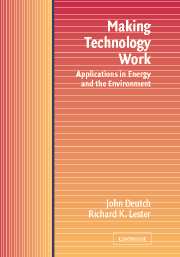Book contents
- Frontmatter
- Contents
- Preface
- 1 Introduction
- 2 Gasohol
- 3 Solar Thermal, Windpower, and Photovoltaic Technologies
- 4 Electricity from Coal
- 5 Controlling Acid Rain from Coal-fired Power Plants
- 6 Greenhouse Gases and Global Warming
- 7 Nuclear Power and Its Fuel Cycle
- 8 Managing Nuclear Waste
- 9 Nuclear Power and Weapons Proliferation
- 10 Natural Gas
- 11 Safety and Risk: Examples from the Liquefied Natural Gas and Nuclear Industries
- 12 Synthetic Fuels
- 13 Fuel Cells For Automobiles
- 14 Energy Models and Statistics
- 15 The Government's Role in Innovation
- 16 Conclusions
- Index
3 - Solar Thermal, Windpower, and Photovoltaic Technologies
Published online by Cambridge University Press: 10 December 2009
- Frontmatter
- Contents
- Preface
- 1 Introduction
- 2 Gasohol
- 3 Solar Thermal, Windpower, and Photovoltaic Technologies
- 4 Electricity from Coal
- 5 Controlling Acid Rain from Coal-fired Power Plants
- 6 Greenhouse Gases and Global Warming
- 7 Nuclear Power and Its Fuel Cycle
- 8 Managing Nuclear Waste
- 9 Nuclear Power and Weapons Proliferation
- 10 Natural Gas
- 11 Safety and Risk: Examples from the Liquefied Natural Gas and Nuclear Industries
- 12 Synthetic Fuels
- 13 Fuel Cells For Automobiles
- 14 Energy Models and Statistics
- 15 The Government's Role in Innovation
- 16 Conclusions
- Index
Summary
Many experts believe that nonrenewable fuels, in particular oil and gas, will eventually become so scarce and therefore so expensive that they will no longer be practical large-scale energy sources. Moreover, the use of coal and other fossil fuels imposes major environmental burdens. Therefore, it is prudent to develop energy technologies based on renewable energy sources and introduce them commercially if and when they become economically competitive.
There are many renewable energy technologies to consider. First are those that rely on natural terrestrial forces: wind, geothermal, hydropower, and tidal power. Second, there are technologies that rely directly on solar energy. These include solar hot water heating, solar thermal electric conversion (either in solar “power towers” or in the more exotic form of solar power satellites), and photovoltaics. Some terrestrial energy sources can be regarded as indirect forms of solar energy. For example, solar ponds and ocean thermal energy conversion (OTEC) rely on solar-heating-induced temperature gradients. Similarly, solar heating of the atmosphere drives the winds. Biomass, another important renewable energy source, can also be regarded as an indirect form of solar energy.
We shall not analyze all these technologies in this chapter. Rather our purpose is to describe a process for evaluating and comparing competing technologies. We consider three important renewable energy technologies in some detail: solar hot water heating, wind energy, and photovoltaics. In each case the task is to evaluate the technical and economic feasibility of substituting the renewable technology for traditional energy sources.
- Type
- Chapter
- Information
- Making Technology WorkApplications in Energy and the Environment, pp. 17 - 48Publisher: Cambridge University PressPrint publication year: 2003



